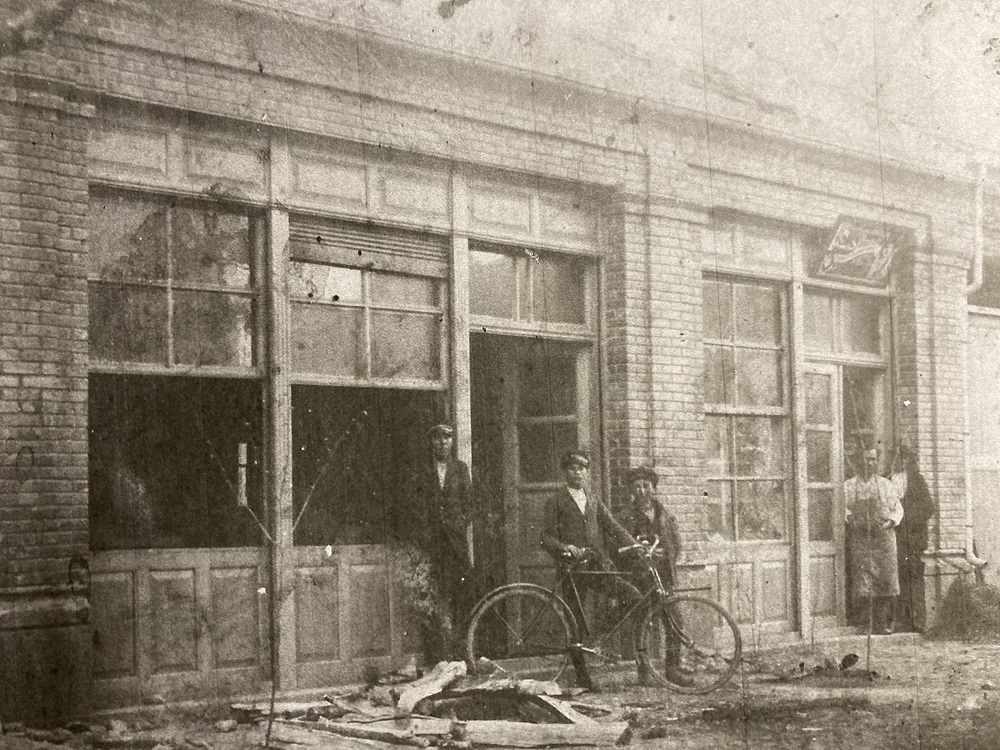
Those who love painting have certainly come across his name. George Pastakas. Born in Florina in 1956, he studied at the Royal Academy of Fine Arts in London and has had numerous exhibitions at the most important art venues in Greece, while he has also represented our country in international events. Admirers of George Pastakas are aware of the great influence of Byzantine art and the landscape of Tinos on his work (last summer he inaugurated a series of works inspired by the landscape of Tinos, entitled “Holy Land“, at the Moschoulion School).
With his first literary venture, “The Road with Seven Doors” (Artemis Publications), he tries to reconcile with his family traumas on the one hand, and on the other hand he offers us the opportunity to discern another figure that subtly dominates his works: it is his imposing grandmother, Nevena. George Pastakas puts aside his colourful brushes for a while and decides to “paint” on paper, equipped only with his pen and his “naked” soul. Exclusively on Days of Art in Greece, George Pastakas shares his thoughts on the “birth” of this book, but also on its defining influences and the direction art is taking in the years of political correctness and artificial intelligence.
Did you “struggle” for a long time with the idea of a novel, or was it a spontaneous decision?
I struggled. It was the most difficult period of my life and in this way, I managed to find redemption. And because I was attached to Nevena, knowing how difficult her life was, her “image” kept me going so that I could move forward one step at a time. The book began writing in 2002 and was completed in the summer of 2022, with some memories that were strangely brought back to me by a neighbor, the “Koula” of my book, whom I met by chance years later in Tinos. She reminded me of images from my childhood, games and moments I had forgotten-all the things I mention in the last chapters of the book.

The family of Dimana, with the patriarch of the family. From Ohrid.
Does chronicling one’s family experiences help one to distance oneself from them or become more familiar with them?
I personally, as I told you, felt redemption. I was trying to get the poison out of me and at the same time I wanted to chronicle a very difficult life of a person who inspired and moved me. Somewhere I wanted to give a slap in the face to those who betrayed me with this book. From time to time I wrote it very quickly and whenever I went to reread it, it was too hard for me, I cried.
Apart from the narrative of the experiences, is there some kind of fiction in the storytelling of your book? If so, what is its contribution?
The only fiction that exists in my book is in the chapter where Kia is introduced to the Macedonian Struggle. This is the scene where she meets the Cretan fighter, but as for her, the end of the chapter incorporates all the hearsay about the mystery of her disappearance.
What freedoms does the novel form give the artist? To an artist who, like you, has learned to express himself mainly through painting?
In the beginning, I tried to turn the first pages into artwork. But only words could bring to life the figure of Nevena, the people she lived with and the people I grew up with. It is a psychograph. The “seven doors” of the title are the seven families, are the seven sins, are the seven seals. It is a sacred number, which is here deified in an “unholy” way and in the end consecrates the protagonist of the book.
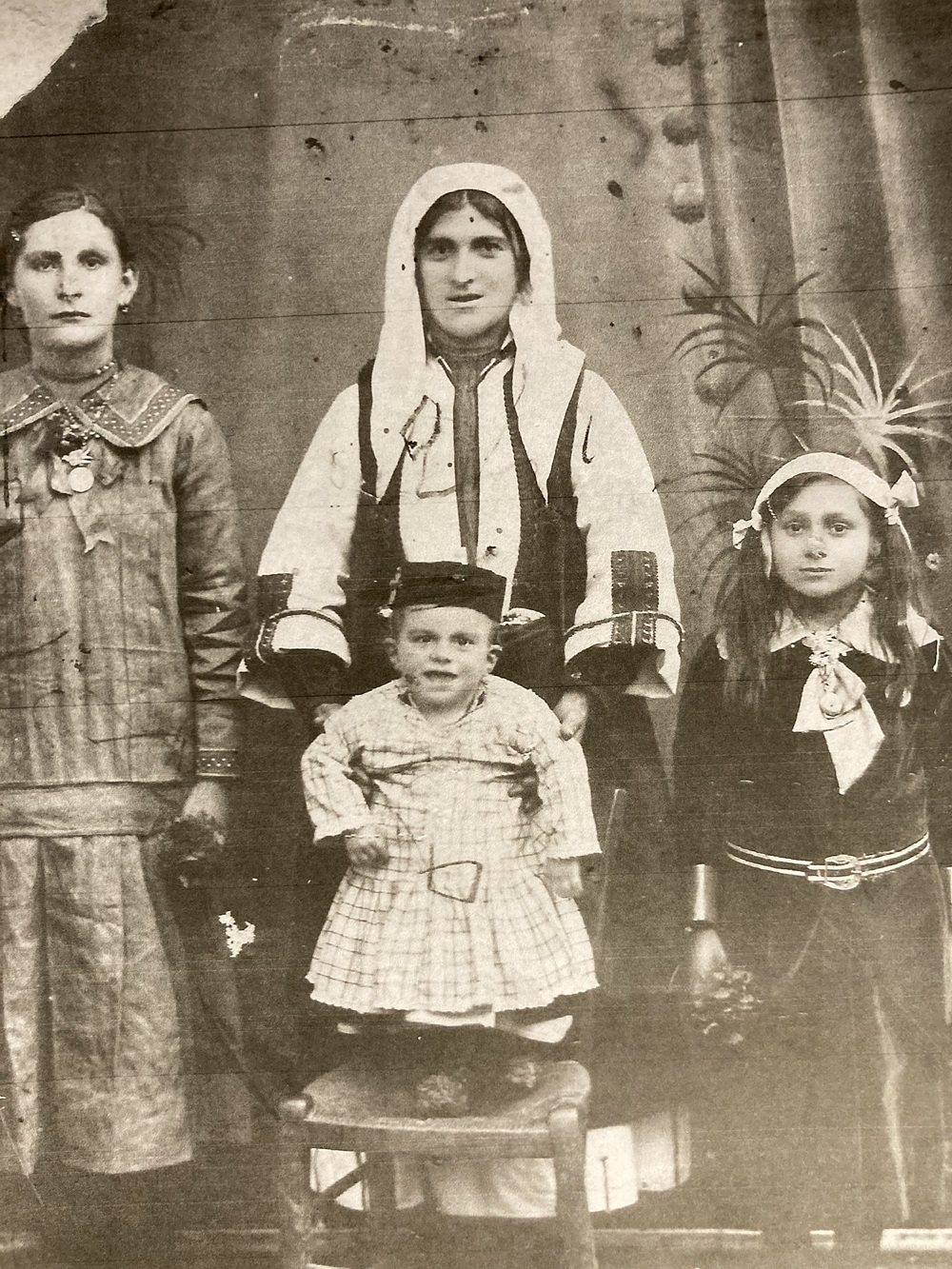
On the left is Nevena, aged 14. In the centre, Trayani holds Stefanos. On the right, Paschalia
In your memories it seems clear that Nevena is dominant. How did her religiousness influence your artistic work?
Nevena had faith and at the same time did not have faith. And she passed that on to me. I remember her going to the church, but she always wanted to be alone. When she saw priests or others around her, she would leave. Likewise, whenever I want to ask for something, I don’t want others around me. I want it to be a secret, underground arrangement. The Supreme Being is always listening. There is no need for the intermediary links, golden robes and the like. Man prays at any place and most importantly cannot live without faith. He is weak, he is too small, and the coincidences in our lives are never coincidences-there is another power guiding us. In this way, Nevena had her own way of communicating with a higher power that gave her courage to go on, because there were also many traumas she had received in life. She had buried two children within two months. Nevena asks “why”, but from this point on she remains silent.

The wedding of Nevena with Petros
What is the most important hagiography and what are the texts of ecclesiastical literature that have permeated your painting and literary work?
Byzantine art is one of the greatest moments when Man himself was able to connect the divine with the human element, so that he could understand the presence of God or the Saints in this world. I think that through this art the soul is reborn. In the Palaeologian era, Byzantine art reaches its zenith, and it is no coincidence that Rublev in Russia, when he becomes a pupil of Theophanes, develops the art of hagiography even further. Unfortunately, the fall of Constantinople and the semi-literacy brought about by the Turkish yoke brought Byzantine art to a second level. Of the texts, the Psalms of David translated by Kalvos is something that has shocked me. Other texts fascinate me as well. The Book of Revelation. The liturgies of Roman the Melodist. The Good Friday service-Nevena then became one with the dead. Ecclesiastes, still, captivates me with its ambiguity and paradox; it contains both Greek and Jewish spirit. It is a text that has managed to remain in the ecclesiastical realm, it has not been silenced.
Are there any literary or cinematic works that inspire you?
I love poetry and especially Rainer Maria Rilke. His oeuvre played a significant role for my own work. It helped me to keep my patience, because as he said himself, “for a work of art to survive it must remain silent, only time can judge it or bring it to the surface.” This has been my path in the visual arts and also with regard to the book. I was waiting for time, which would give me the freedom to be able to get it out and give it to other people. In cinema, those who have influenced me very much are Pier Paolo Pasolini, Lucino Visconti, and Italian neorealism in general. Visconti in particular was able to bring an era to life in the smallest detail, something that is no longer done in cinema. It was art for art’s sake. On the other hand, I am fascinated by Pasolini’s simplicity in how he managed from nothing, with only a few peasants, to create a masterpiece, he illustrated the Gospel according to Matthew. Andrey Tarkovsky is another great figure-with works of impeccable art. All the others follow. When I work, I always listen to Mahler’s Fifth Symphony. For me it is the pinnacle of musical art.

Anza on the left, Nevena on the right. In mourning for the death of Lazaros. From the left the babies: Lili, Kostas, in the centre, on the bike, George of Nevena, Marika and Katina.
We see groups of activists in many galleries around the world, “intervening” in artworks. How would you comment on these incidents?
People have hatred because of political unrest. This is not interference. It is a felony. We now coddle the vandals, we let them take out their frustrations on top works of art by destroying them. It perpetuates a sick atmosphere. Unfortunately, they believe that in order to be known, they have to hurt someone or something.
How would you comment on the limitations imposed on the artist by contemporary political correctness?
Censorship has not always existed. Obscurantism starts from the period when the Christian religion dominated, misinterpreting some things on the Gospel of Faith. Man was free until then. Hadjidakis said that “sin is Byzantine and eros is ancient” .Political situations now, the first thing they create is guilt. And for the artist, guilt prevents him from being able to breathe and create.
What is the future of the arts under the shadow of artificial intelligence?
It scares me. It’s something that’s going to happen, but I don’t think it’s for the best. That is, the world will officially enter into a period of darkness. Art has nothing to do with any of these things. In art you take twenty steps backwards to be able to hold on and create. But technology and science are moving forward. If they help the living standard of man, to find medicines, to eliminate suffering and wars, I can understand it. But I’m afraid it will be for the destruction and end of an era. Art, however, I don’t know if artificial intelligence will be able to defeat it. Art always finds a way to survive.
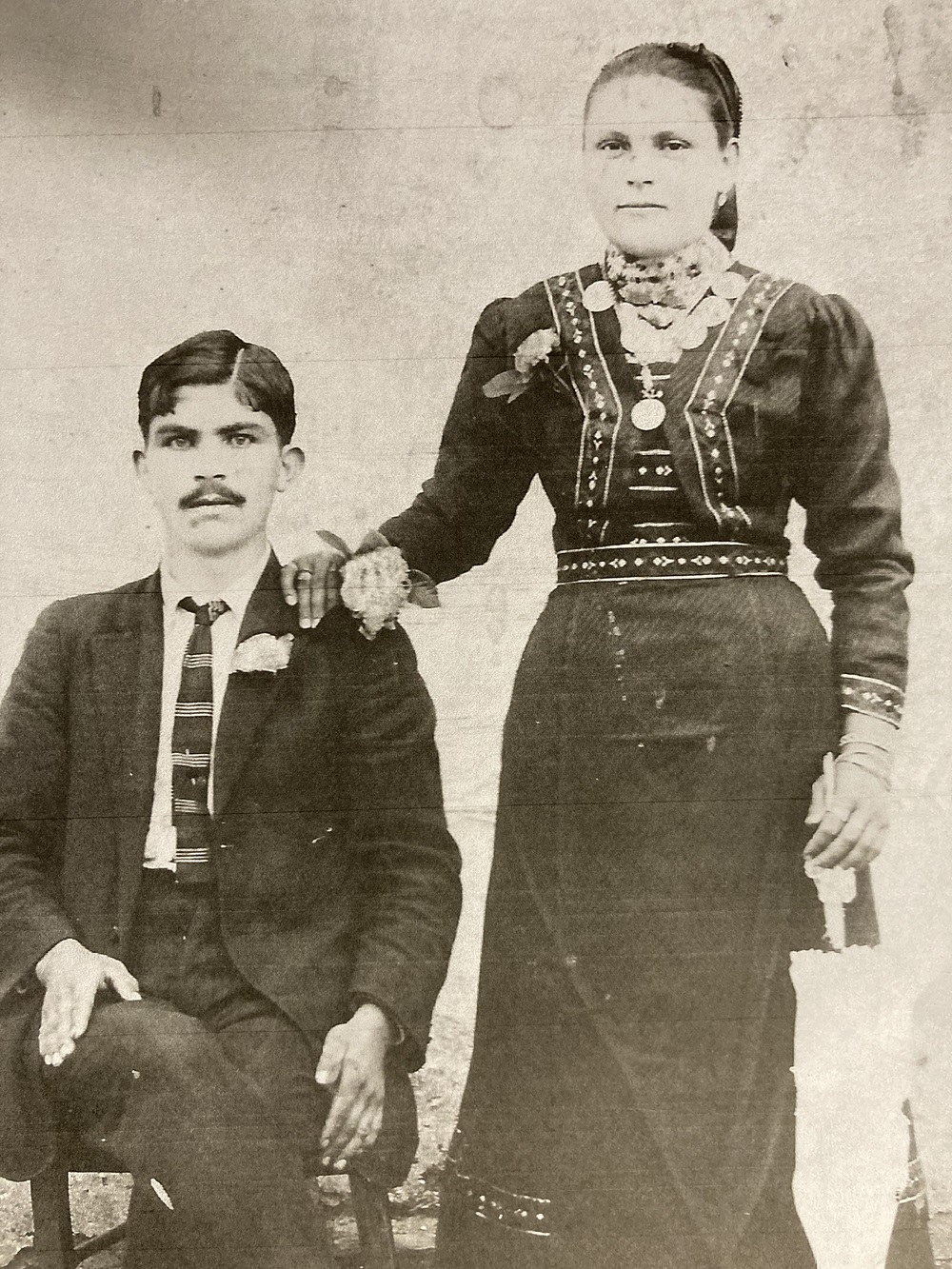
Nevena’s sister, Ioanna, with her fiancé. Just before he leaves for Athens
How do you manage to remain a “constant gardener ” of art?
I’m not alone. There are two people, my wife (Rania) and my daughter (Venia), who endure my whole life. Thanks to the patience of my wife, who kept the wheel, I found strength in terribly difficult times. As an artist, I have come to leave a mark. If the first wave, will take my work to perish, so let it be… Mostly we need to appreciate the people behind an artist, a creator cannot be alone. The state of mind of an artist is such that it is constantly fluctuating. Some times he flies in the sky and some times he sinks into Tartarus. He must have an anchor. In this I have been very lucky.




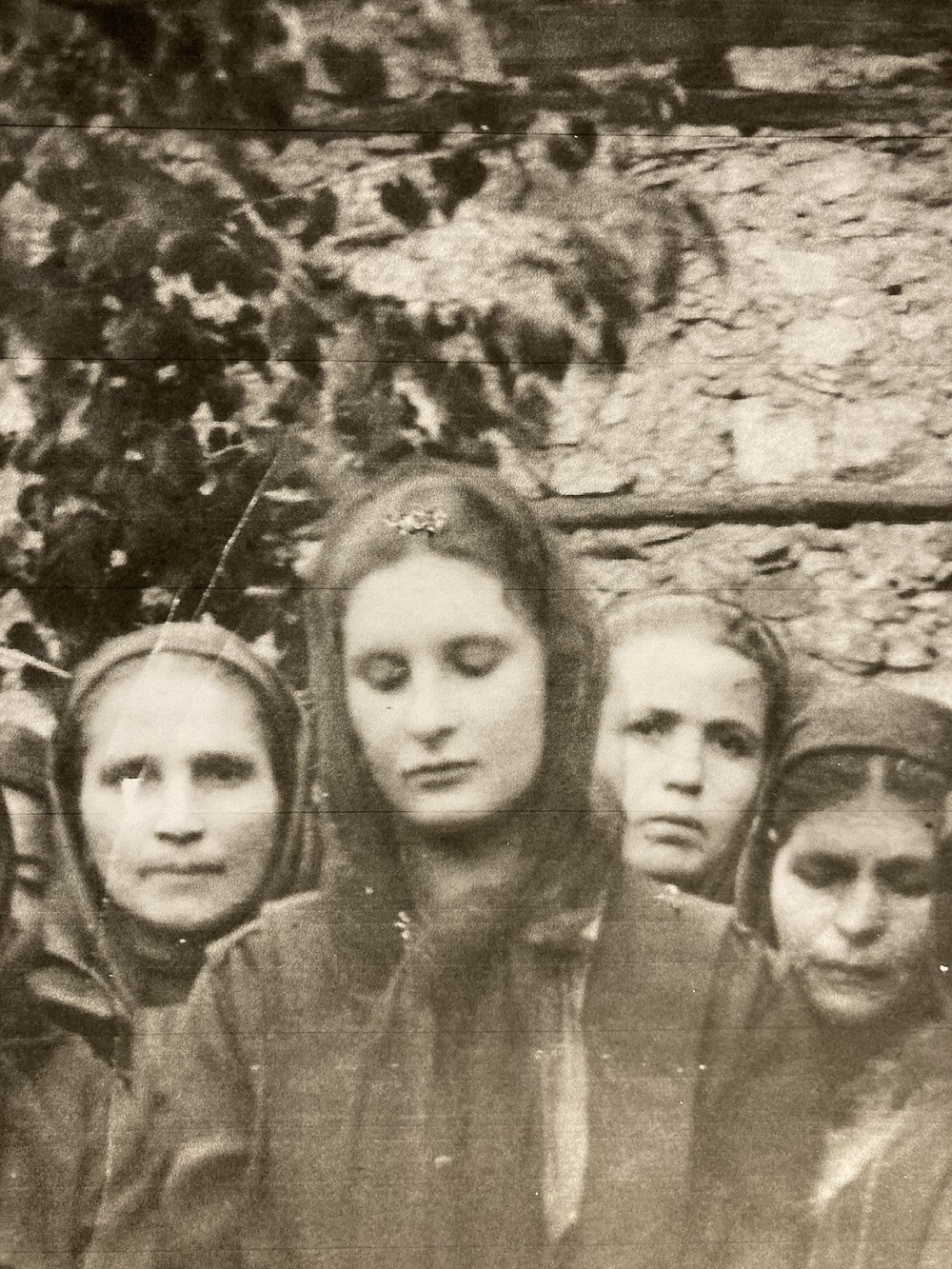
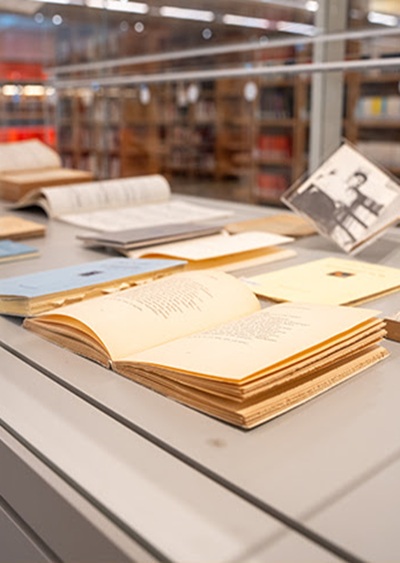

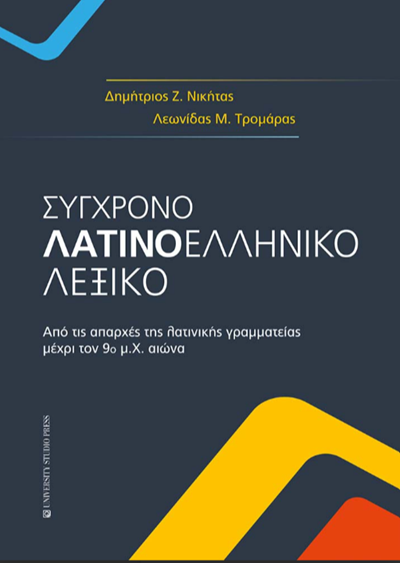
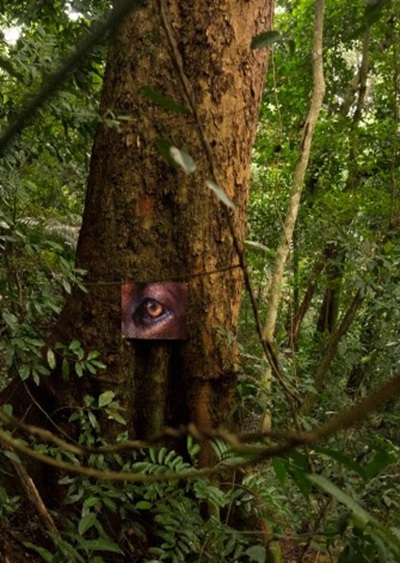


Leave A Comment